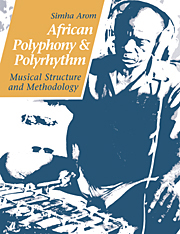Book contents
- Frontmatter
- Contents
- List of illustrations
- Foreword by György Ligeti
- Preface
- Acknowledgements
- BOOK I THE MUSIC OF THE CENTRAL AFRICAN REPUBLIC
- BOOK II AFRICAN POLYPHONIC MUSIC
- BOOK III TECHNICAL TOOLS: METHODS OF RECORDING POLYPHONIC MUSIC FOR TRANSCRIPTION
- BOOK IV THEORETICAL TOOLS
- BOOK V THE ORGANISATION OF TIME IN AFRICAN MUSIC
- 1 A brief survey of Western rhythmics
- 2 Towards a precise terminology
- 3 African rhythmics
- BOOK VI STRUCTURAL PRINCIPLES AND THEIR APPLICATION
- Conclusion
- Bibliography
1 - A brief survey of Western rhythmics
Published online by Cambridge University Press: 27 January 2010
- Frontmatter
- Contents
- List of illustrations
- Foreword by György Ligeti
- Preface
- Acknowledgements
- BOOK I THE MUSIC OF THE CENTRAL AFRICAN REPUBLIC
- BOOK II AFRICAN POLYPHONIC MUSIC
- BOOK III TECHNICAL TOOLS: METHODS OF RECORDING POLYPHONIC MUSIC FOR TRANSCRIPTION
- BOOK IV THEORETICAL TOOLS
- BOOK V THE ORGANISATION OF TIME IN AFRICAN MUSIC
- 1 A brief survey of Western rhythmics
- 2 Towards a precise terminology
- 3 African rhythmics
- BOOK VI STRUCTURAL PRINCIPLES AND THEIR APPLICATION
- Conclusion
- Bibliography
Summary
The beat acts as a signal, not as mere duration. It binds into coincidences, binds rhythms into instants that will stand out.
Bachelard, La dialectique de la durée, p. 122INTRODUCTION
This Book deals with the temporal structure of African music, particularly African polyphony. All polyphonic music requires a temporal reference unit to provide a common denominator for its parts. We will therefore be discussing measured music, i.e., music comprised of durations with proportional values.
Let us recall that the distinction between measured and unmeasured music has a long history. It existed in the cultured music of the ancient Greeks, and in medieval musical theory, in the contrast between the cantus mensuratus (measured chant) and cantus planus (plain chant). Closer to our own times, it can be found in classical opera, where arias or measured pieces alternate with unmeasured recitativo secco.
Measured music, sometimes referred to by the Italian expression, tempo giusto, is thus defined by contrast with unmeasured music. The latter is not governed by fixed quantities, i.e., the values of durations are not strictly proportional. In unmeasured music, a note is only meaningful in its position with respect to preceding and following notes, i.e., in a melodic pattern. In measured music, however, all durations are strictly proportional.
According to Rousseau's (1768: 283) dictionary, the term measured ‘corresponds to the Italian a tempo or a batuta’. Proportional durations must be based on a reference unit. Different epochs and civilisations have had different ideas of such a unit. Ancient Greek music was based on a chronos protōs, the smallest indivisible unit of duration, whose multiples formed the foot and the metre. In the West, this unit is the beat provided by the conductor, whence the term batuta in Rousseau's definition of measured.
- Type
- Chapter
- Information
- African Polyphony and PolyrhythmMusical Structure and Methodology, pp. 179 - 200Publisher: Cambridge University PressPrint publication year: 1991
- 2
- Cited by



